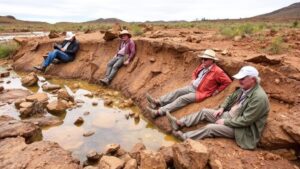Testing Gravel Depths for Isolated Gold Nuggets in Narrow Channels
Testing Gravel Depths for Isolated Gold Nuggets in Narrow Channels
The quest for gold has captivated many, and one of the most challenging environments to search for this precious metal is in narrow channels. Understanding how to effectively test gravel depths for isolated gold nuggets enhances the probability of successful prospecting. This article provides a detailed examination of techniques used to test gravel depths, challenges faced, and practical approaches backed by research and real-world applications.
The Importance of Depth Testing
Depth testing is a crucial step in gold prospecting as gold tends to accumulate in specific stratifications within sediments. Accurately identifying gravel depth can lead to significant findings, especially in environments where isolated nuggets are hidden beneath layers of sediment.
- Gold behavior: Gold is dense and often settles at the bottom of a channel.
- Layering effects: Different sediment layers can trap gold in varying depths.
In narrow channels, the dynamics of water flow, erosion, and deposition fluctuate, necessitating careful assessment of how deep to dig or probe for potential gold deposits.
Methods for Measuring Gravel Depth
There are several practical methods for testing gravel depths in narrow channels. Each technique has its advantages and disadvantages, depending on the specific context of a prospecting site.
- Using a Hand Probe: A hand probe is a simple yet effective tool for measuring gravel depth. Prospectors can utilize a steel rod to push into the gravel until it reaches bedrock or a significant compacted layer.
- Hydraulic Excavation: For larger exploratory studies, employing small excavators or suction dredges can uncover deeper gravel layers efficiently.
- Geophysical Surveys: Techniques such as ground penetrating radar (GPR) can help visualize the subsurface layers without invasive digging.
For example, a field study in Alaska utilized GPR to locate potential gold-bearing deposits along riverbanks, resulting in a targeted excavation strategy that reduced the time and effort spent on less promising sites.
Challenges in Gravel Depth Testing
While testing gravel depths shows promise, several challenges can impede accurate assessments:
- Water Saturation: Channels often fluctuate between dry and flooded conditions, impacting gravel consistency and depth measurement.
- Variable Sediment Composition: Different types of sediments can confuse results. For example, clay may conceal gravel and mislead depth assessments.
- Smaller Isolated Nuggets: The tendency of gold nuggets to be isolated makes it critical to select multiple probing locations.
In a case where sediment fluctuates considerably, such as during seasonal floods, prospectors must be prepared to adapt their strategy to account for changes in sediment deposition.
Real-World Applications and Techniques
Understanding the nuances of tested methods can enhance gold prospecting endeavors. One effective approach is the use of stratified sampling, which can allow prospectors to identify localized areas with a higher density of nuggets. For example, in California’s Yuba River, prospectors have found concentrations of nuggets by systematically sampling different depths and identifying layers with higher gold content.
- Strategic Sampling: Incorporating grid systems in the sampling process aids in identifying deeper pockets of gravel.
- Interpreting Results: Record keeping of findings over time can develop a profile of gold distribution in specific channels.
Actionable Takeaways
To effectively test gravel depths for isolated gold nuggets in narrow channels, prospectors should consider the following actionable strategies:
- Use a combination of hand probing and more advanced techniques, such as GPR, to develop a comprehensive understanding of the site’s geology.
- Be adaptable to environmental changes that may affect sedimentation and access to gravel layers.
- Document all depth measurements and sediment types to refine future prospecting techniques.
To wrap up, testing gravel depths in narrow channels requires understanding the behavior of sediments and the gold itself. By employing a multifaceted approach and remaining adaptable to conditions, prospectors can improve their chances of discovering isolated gold nuggets hidden beneath layers of gravel.

